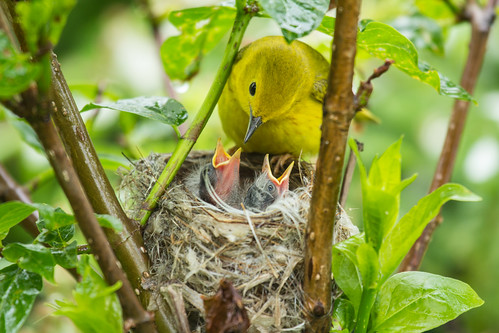In my first spring of birding back in 1975, I saw a Mourning Dove fly up from deep within some branches in a conifer, just below eye level. I pulled a branch back to see where she’d been sitting, and lo and behold—there was the first real bird nest I’d ever seen. It looked rather flimsy but held two lovely white eggs. I was enthralled.
I couldn’t help but check the nest the next day. A pair of Mourning Doves was feeding nearby, so I presumed the female was not on the nest. And when I pulled the branch back, she wasn’t there, but neither were the eggs.
Neither my Golden guide nor my Peterson guide said anything about Mourning Dove nests. My Audubon Water Bird Guide mentioned how flimsy Mourning Dove nests are, and it was a little comforting for me to think that was the problem—the nest bottom really had been loosely woven in a way that made it seem possible the eggs had dropped out of the bottom. But how could I know for certain, when I knew another likelihood was that I myself had helped a predator discover the nest? I’ve discovered quite a few nests since then, but never ever by peeking through the branches of trees or shrubs. If a bird wants to keep its nest hidden, who am I to deny it that sense of security?
I am an avid birder myself, and, living in high plateau country in Bryce Canyon National Park, am currently feeling joyously inundated by the return of our Spring migrants. After listening to your Brown Creeper episodes, I thought I'd drop you a line. I love these birds so dearly, they are some of my favorites here in the ponderosa pine forest we call home. I meander through the woods each day, birding and observing and communing, and often sneaking peeks under husks of loose bark to see if there happens to be a creeper nest tucked inside. Last year, I finally came across one of these nests, in active use, and given away by busy parents with beaks full of moths and by peeping chicks. I was so excited and happy to discover a nest site! I took some photos and recorded the sounds of the peepers.
Here I lament: after noting the nest location, I waited until the breeding season was over and returned to the site. I wanted to better understand the nest construction, and so attempted to reach up with sticks and branches to try and remove the bark husk. I failed, it being too high up, leaving a broken piece of branch lodged in the space between the husk and the snag. I felt suddenly very remorseful seeing this fragmented shard protruding from the nest entryway as evidence of a violent invasion, and vowed to never try to so recklessly indulge my curiosities again.
This year, I followed a brown creeper through the forest, observing her flight from tree to tree. Sure enough, the bird takes me right back to the snag with the nest, and I watch as she works her way up, finally poking her head into the nest location before flying away. What shame I felt in that moment. Before attempting to steal the nest, I had read that creepers are not known to reuse them. However, this moment really drove home for me the importance of tending to my curiosity with more care.
Perhaps one of your podcasts could tackle the challenge of balancing curiosity and wonder-fueled actions that might not be in the best interest of the birds/or in the best naturalist form, with maintaining respect for the space and well-being of our feathered friends.
And thanks to Kadi, today’s blogpost and podcast is just that. If you’re going to search for and monitor nests, please follow the guidelines provided by the Cornell Lab of Ornithology’s NestWatch program. A great many birds give us wonderful glimpses of their lives. Restraining our curiosity about their more hidden activities is hardly a sacrifice relative to the sacrifice the birds would make if we damaged their nest or led a predator to it. The more we learn about birds, the more we can’t help but love them. The Mills Brothers sang a sad old song, “You Always Hurt the One You Love.” Let’s prove them wrong.




